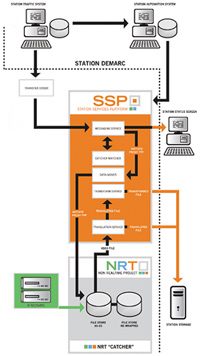PBS Preps NGIS for Deployment
LAS VEGAS
Among A-list topics at PBS's TechCon in April was the status of the network's "Next Generation Interconnect System" (NGIS). Despite past delays and sidetracked approaches, the NGIS train has definitely left the station and is gathering speed. TV Technology recently received an update from Chief Technology Officer John McCoskey and Jerry Butler, Senior Director, Interconnection Replacement Office, along with feedback from alpha testers and a key technology provider.
Most people think of NGIS in terms of its file-based non-real-time (NRT) subsystem, since that represents the most innovative and challenging part of the design, according to McCoskey. But it's much more than that, he added.

"NGIS is an ongoing 10-year project that encompasses capital infrastructure, satellite capacity leases and technical elements of the system used to distribute content from public television producers to stations... many objectives have already been completed," he said.
Butler said the project is in multiple phases, "the first being a conversion to standard DVB satellite transmission, followed by consolidation onto the new AMC-21 spacecraft launched in August 2008. We also transitioned from primarily standard definition services to nearly all high definition in 2008. We're currently alpha-testing the next major phase—file-based non-real-time distribution of content to the stations."
TRAFFIC & ENGINEERING
What's different and why will it succeed this time? "We've heard that comment many times," McCoskey said. "NRT will have the most impact on station efficiencies and operational workflows, so it's of vital interest to the station traffic and engineering communities... frankly, it's taken more time than anticipated for the underlying technology to mature and achieve enterprise-class reliability. Now that we've reached that point, much of the NGIS focus shifts to integrating NRT with the diverse station workflows and staffing models."
PBS worked with its industry colleagues to create AS-03, a multi-vendor standard based-on the SMPTE MXF format for file-based distribution that is designed to work with nearly all station video servers, according to Butler.
In addition, "we have [deployed] new satellite receivers at all stations and moved services and downlinks to the recently launched AMC-21 satellite," said McCoskey, "and have selected [International Datacasting Corporation] the primary vendor for the NRT subsystem."
Ottawa-based IDC is a leader in DVB/IP systems, with more than 150 installed networks worldwide and provides systems for TV broadcasters such as Hearst-Argyle and Tribune, major radio networks like NPR and CBS/Westwood One, as well as VOD applications for EchoStar.
"We're providing the hardware and accompanying software needed to prepare, address, schedule, and deliver video content in the form of files, where they have to be and when they have to be there," said Diana Cantú, the company's executive director, Business Development for the Americas.
McCoskey said stations were glad to see a real, working prototype at TechCon. "We showed end-to-end management and transfer of a standard file that played-out on an off-the-shelf [Omneon] video server. After multiple years of just talking about NRT... stations were able to see and touch working gear."
PBS has already engaged several key stations, all of the major content distributors, the primary station traffic software providers [Myers & Broadview] and the file transfer subsystem vendor to participate in the alpha testing process. "The result is very station-centric and ready for testing in a parallel environment at multiple locations," said Butler. Alpha testing is currently in progress with plans to move to beta testing with about 10 more stations later this year and a full-system rollout in 2010.
WHEN WILL IT BE READY?
(click thumbnail)
The NRT workflow Most of the questions at TechCon revolved around when the gear would be available and ready for action, according to Butler. Stations had "specific questions about technical compatibility with their existing plant and how we will handle the equivalent of missed feeds or late changes to topical content. These scenarios will be a core part of the systems and their operation," he said.
Ron Hetrick III, director of technology at WITF-TV, the PBS station in Harrisburg, Pa., said the alpha group of stations is now focused on the "Station Services Platform" (SSP), the file management and movement system between the PBS and station systems.
"The traffic system interface to the SSP is [vital] in terms of program scheduling and movement of files from PBS to local servers," he said. "Vetting these systems is underway now... for this to be a successful launch in a system where many stations operate independently, information sharing and collaboration will be the key to success."
Alan Popkin, director of TV Engineering & Technical Operations at KLCS-TV in Los Angeles, also an alpha group member, noted the goal is not to change the station's workflow, but "rather to seamlessly integrate another delivery pipe into the existing air chain... if implemented correctly, it should be virtually transparent to the station, except for monitoring."
Popkin participated in meetings with PBS which defined a more station-centric configuration than previous approaches. "It was quickly apparent a lot of things were needed before you could roll this thing out... and that's where the station-facing SSP concept for non-real-time delivery came from," he said. "In theory, moving files by satellite ftp or datacast is well understood and fairly trivial... [what can] take time is grinding video in the transform engine. A lot of care is being given to not creating a 'funnel,' where a lot of content is delivered to the station, but then can't get into the [on-air] server because of the speed of transform and other bottlenecks."
NRT will provide a higher availability and more reliable service to stations, McCoskey emphasized. "The impairments caused by transmission errors on our current linear feeds will be eliminated for all NRT content, which will represent about 70 percent of the total content delivered to stations," he said. "We plan to under-promise and over-deliver, so until we get through alpha and beta testing we are not going to lock down deployment dates... this will not go into production operation until it is absolutely rock solid."

The professional video industry's #1 source for news, trends and product and tech information. Sign up below.
